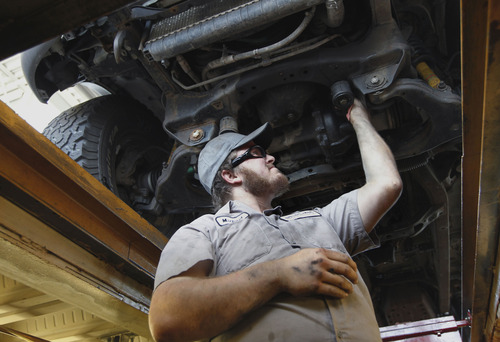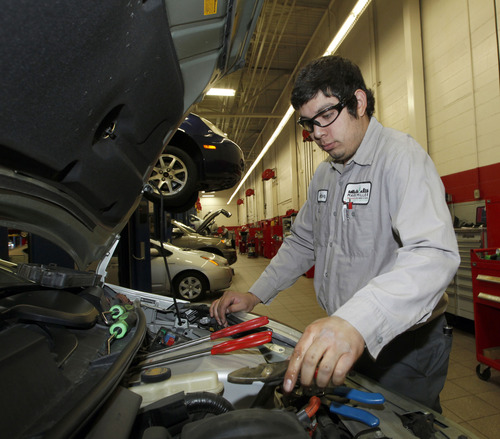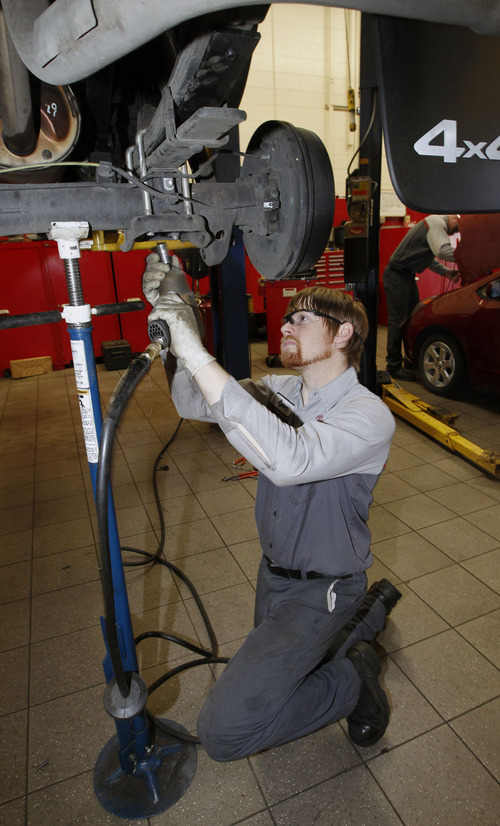This is an archived article that was published on sltrib.com in 2013, and information in the article may be outdated. It is provided only for personal research purposes and may not be reprinted.
A couple of months ago, Greg Lamb's 23-year-old son went skiing with some buddies and borrowed his 2003 Nissan Frontier.
"While it was in four-wheel drive, the truck started making horrible grinding noises," Lamb recalled.
The Salt Lake City resident guessed the problem would cost $200 to fix, but replacing the front-end differential turned out to be more like $900.
"It was much more expensive than I thought," he said. "This is the first major repair I've put on it."
Owning a car has never been cheap, but according to one study, costs associated with the privilege are rising. Taking into account car payments, insurance, fuel, tires and depreciation, the typical American will spend $9,122 on a sedan this year, up nearly 2 percent from last year, according to AAA's annual "Your Driving Costs" analysis. SUV owners can expect to fork out $11,599 this year, up more than 2 percent.
Although the price tag for tires remained static over the past year, car insurance rates on average rose 2.76 percent, to $1,029 annually. And it's no surprise that prices at the pump increased, up 1.93 percent.
But the big jump in owning a car came from maintenance, which rose more than 11 percent. The study noted that estimates are based on labor, parts and the purchase of an extended-warranty policy.
The increase surprised Mark Miller, owner of three new- and used-car dealerships in Salt Lake County. Miller, who bought his grandfather's dealership in 1976, said a lot of auto manufacturers offer two years of free maintenance on new vehicles, which would mean no costs for the consumer during that period. He added that the cost of his parts has not increased nor have wages (i.e. labor).
Miller's service manager, Brian Lawrence, further disputed the increased cost of maintenance, saying upgrades in vehicle technology — from fuel filters to iridium spark plugs — make the need for maintenance less frequent.
"Something's goofy," Lawrence said. "The quality of parts has significantly improved."
If, however, maintenance costs are on the rise, Miller's best guess as to why boils down to having many more older models on the road.
"The age of the fleet is older than it's been in modern history," Miller said. "People are keeping their cars longer because of the economy, and as cars get older, they need more maintenance."
That could change this year. Although new-car sales plummeted from 17 million in 2008 to 9 million in 2011, they have been steadily rebounding since, with forecasters projecting 15.5 million new sales this year.
"That's good news for everybody," Miller said.
If you're in the market for either a new or used car, the AAA study reinforces that it's important to budget for the full costs of car ownership and not just the monthly payment, said Rolayne Fairclough of AAA Utah.
"This is a nice little reminder that there is a lot more involved to buying a car than the sticker price. You should kind of have an idea going in where costs of gas and maintenance are going to exceed just the payment."
With 80,000 miles on his 2003 Nissan truck, Lamb thinks the vehicle still has a lot of life, but more repairs could be in the future.
"Maybe I should have paid attention in shop class in high school," he said.
Twitter: @jnpearce —
Tips to get better gas mileage
Avoid jackrabbit starts and accelerate gradually.
In summer, try to drive during cooler parts of the day, when denser air can boost power and mileage.
Avoid long warm-ups in the morning because they are unnecessary and waste fuel.
Today's air conditioners create less drag on the engine than driving with the windows open. Use them.
Maintain recommended tire pressure because low pressure reduces fuel economy and can damage tires.
Keep the air filter clean because clogs reduce fuel economy and increase exhaust emissions.
Drive the speed limit.
Source: AAA Utah







